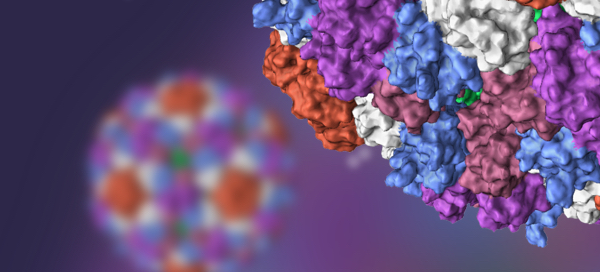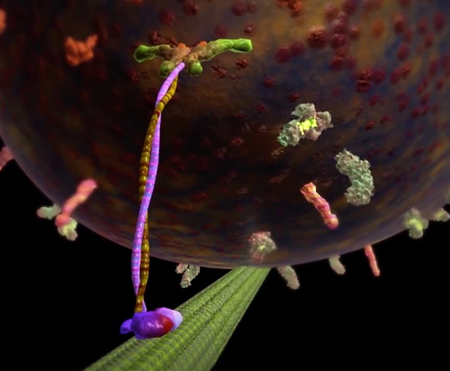
My goal in this longish post will be to paint in your mind a very lucid picture of health, not by rendering minute details, but by applying the impressionist’s style to offer a vivid portrait when viewed at the right distance. The details are important and I will endeavor to fill in many of them later on, but for now I think that perspective, contour, and a bit of color will afford the best overview and justify my insistence that health needs to be redefined.
Foundations of Health: An Essential Bit of Background
Through the lens of physics, health is the optimal flow of electrons through an extremely complex set of algorithms, many trillions of them, that sustain and animate a living being from moment to moment. We can all understand the principles of health, with carefully conducted science illuminating the way. Evolutionary biology adds context by revealing the processes that shaped and perfected the algorithms of life over vast spans of time, but it's not the only valuable perspective.
The whole thing—the vast and beautiful and profoundly complicated universe—leads some to posit an intelligence at the root of it all, an eternal master-architect who whispered the universe into being. As a student of Nature, standing in awe of its magesty, it seems small-minded to denigrate that logic, and even more petty to alienate fellows of humanity. There will be no rants or crusades against metaphysical viewpoints in these posts, but I fully embrace the principles of evolution, because life is nonsensical without them. Something we all agree on is that we are here together and we should make the best of it, no matter what the source of all this unfathomable complexity. We all value health, and this series is for anyone who cares about making the best of life.
The elements that contribute to life—hydrogen, oxygen, carbon, nitrogen, phosphorous, etc.—each have their own simple algorithms. That is, they each combine or interact with other atoms in different ways, opening up vast possibilities for new algorithmic functions to exist. It is like Nature (God, if you wish), in her most violent convulsions (supernovas), littered the universe with Tinker Toys that can self-assemble to form animated systems under just the right conditions. The periodic table of elements provides a summary of these simple algorithms, which we refer to as valences, electronegativities, isotopic states, etc.
When atoms interact to form bonds, they produce more complex functions. When, in the course of evolution, these elaborated algorithms became capable of consistently channeling the flow of electrons toward a specific chemical or mechanical outcome, the foundations of metabolism had emerged. Biochemistry is essentially the study of how a multitude of simple algorithms (biomolecules) combine to conduct electrons systematically, resulting in a series of molecular transformations (biochemical pathways) that, in the aggregate, comprise an integrated set of more complex functions. We call this ordered layering of chemical algorithms life.
Biochemistry is essentially the study of how a multitude of simple algorithms (biomolecules) combine to conduct electrons systematically, resulting in a series of molecular transformations (biochemical pathways) that, in the aggregate, comprise an integrated set of more complex functions. We call this ordered layering of chemical algorithms life.
Many of the molecular pathways in biological systems form cycles driven by an external supply of electrons (chemically derived), and these cycles, or feedback loops, form the basis of self-regulation—a fundamental feature of life called homeostasis. Physiology is the study of the ordered flow of electrons through self-regulating systems of immense complexity—cells and multicellular organisms.
The chemical processes that constitute life can be analogized to combustion. Life, however, proceeds as a smolder rather than a conflagration. Enzymes are the key to this slow, prescribed burn. Through atomic resonances, these essential proteins modify the energies required to break bonds, allowing electron flow between molecules at relatively cool temperatures. Enzymes have very specific functions, so many thousands of different kinds are required to perform the operations needed for life, and life forms differ from each other to the extent that they possess different enzymatic algorithms.
Without the regulated electron flow afforded by enzymes, the most ordered systems in nature would probably be crystals, but enzymes allow for higher order systems and vast accumulations of complexity. Paradoxically, and fabulously, enzymes transform chaotic systems (systems ruled by diffusion) into ordered ones, and this order is governed by a very special linear crystal called DNA (deoxyribonucleic acid).
By representing in its sequence of four bases the order of amino acids in a protein, DNA codes for the enzymes and structural proteins that make life possible. The processes that got life started on Earth are unknown, perhaps unknowable, but we are here and our health appears to be of primary importance to our remaining here.
The fundamental unit of life is the cell—tiny capsules in which the imperceptible chemical dramas of life play out. The boundaries of cells are profoundly important and rather complex. Besides water, they consist largely of lipids (fats) and proteins, both of which play structural and functional roles. The sizes, shapes, and compositions of cells differ greatly, and these differences bear directly on the functions and performances of cells. For example, a cell that is too small might be too crowded to contain optimal concentrations of chemical substrates (nutrients), while one that is too big might not be able to efficiently distribute them. With our synoptic goal, we will not delve too deeply into cellular structures—not yet—but it is important to appreciate that the operations of cells are performed by tiny spastic robots powered externally by electron donor molecules. These nanobots are the final destinations for electron flow, where external energy is converted to the work of the cell and the heat of metabolism is generated. They operate at phenomenal speeds, yet all cellular processes are limited by the speed of diffusion (how fast molecules passively disperse in solution). This speed limit is one reason why cells are usually very small, and it is why we are mostly composed of water (the solute of life).
With our synoptic goal, we will not delve too deeply into cellular structures—not yet—but it is important to appreciate that the operations of cells are performed by tiny spastic robots powered externally by electron donor molecules. These nanobots are the final destinations for electron flow, where external energy is converted to the work of the cell and the heat of metabolism is generated. They operate at phenomenal speeds, yet all cellular processes are limited by the speed of diffusion (how fast molecules passively disperse in solution). This speed limit is one reason why cells are usually very small, and it is why we are mostly composed of water (the solute of life).
I highly recommend viewing some of the brilliant animations of molecular machines created by scientists. These visual models provide quite accurate, though simplified, depictions of cellular operations (see for example: this video).
All of our movements, thoughts, and feelings result from the actions of cells. Communication between adjacent and distant cells coordinates the activity of an organism, and intercellular communication is 100% chemical. This chemical dependency has profound implications for health.
The cell may be thought of as a complex, intelligent system made of multitudes of simple algorithms (nanobots and simpler chemicals), all of them phenomenally well-coordinated (optimized to work in concert).
Can a cell be unhealthy? You bet! But why? Because the order and efficiency of its algorithms can be disrupted such that the system is no longer operating near its functional optimum.
Atoms cannot "malfunction," nor can most molecules. These elementary algorithms simply exist in unoptimized states. It is their presence or concentration in a complex, integrated system that influences health. The chain of optimal functioning starts at the evolved systems, the nanobots, and it cascades up from there through cells to the whole organism. Of course, cell chemistry is usually the root cause of malfunctioning, but not for evolutionary reasons.
Cellular macromolecules (the nanobots) are evolved, so their shapes and functions are optimized by natural selection, but these evolved molecules represent relatively simple algorithms. Their manufacture requires integration, but their individual functions fall short of the sort of complexity needed to describe them as healthy or unhealthy.
Accordingly, I contend that the elementary algorithms, themselves, cannot be "unhealthy," because they are not sufficiently complex to warrant the use of that adjective. The term health should apply only to highly integrated systems made up of many interdependent algorithms that contribute to an optimizable system--one capable of maintaining itself indefinitely given inputs common to a particular environment. Thus, your liver can be unhealthy if enough of it's normal operations are malfunctioning, but the biochemical pathways that contribute to the unhealthy state are not, themselves, "unhealthy." Rather they are merely malfunctioning with respect to their optimal contribution in the evolved system. This clarification suggests that the cell (or perhaps the organelle) is near the lower end of the spectrum of organizational complexity that should be referred to by the term health and the biosphere is near the other end of that continuum.
The chemical nature of our being makes us vulnerable to the chemistry of the environment, so it is impossible to divorce environmental health from physical health. The linkages between the environment and organisms run deep, extend far, and go both ways. Indeed, not only does the environment regulate life, but life seems to regulate the environment on Earth in fundamental ways. The Gaia hypothesis of James Lovelock is an elaboration of that observation, and the National Geographic production "One Strange Rock" is perhaps the best media production I've seen for articulating the role that life has played in regulating the Earth's habitability.
Almost all of the environmental and genetic linkages associated with health are chemical! Thus, the foundation of health is chemistry—or rather biochemistry—optimized for the process of self-regulation (homeostasis). When I say that health is the optimal functioning of a complex, integrated system, I mean that all of the algorithms comprising the system are operating as determined by an optimizing process. For biological health, this means that all of the algorithms comprising the organism are operating as determined by the evolutionary process and that Nature’s self-assembled hierarchy is in good order.

By understanding the details of cellular algorithms, we might eventually gain a comprehensive knowledge of health. But do we need this in-depth grasp to manage our own health? No, of course not. We need only be aware of the basic processes that govern health and, to some extent, the context by which biological systems came into being. That is, we need to know something about what is natural, and it helps to understand how natural systems became optimized.
By natural, I mean the normative conditions in the environment that Earth has supplied throughout our evolutionary history. By a strict definition, humans are natural—as is our habit of polluting our environment. Perhaps this tendency can be viewed as self-regulation, but that is not a very inspiring thought; it involves the destruction of many other species and, perhaps, eventually ourselves, and I think that we can do better. In order to get ourselves on the right track for long-term, healthy survival, we need to first understand ourselves, and this means looking at ourselves more realistically.
For example, while we usually think of our age as the timespan between birth and now, this conception is only loosely based in reality. First off, your genetically determined existence (your unique combination of DNA) is about nine months older than your declared age, and most of the gene variants that combine to make up your unique constitution have been passed down by your ancestors for millions of years. Second, your molecular composition is in continuous flux, such that you likely have no molecules now that existed in you from just ten years ago. Finally, at the level of the germline (the immortal cell line), you are 3.5 billion years old, give or take a few hundred million years. It took that long for the cellular algorithms to become integrated enough to produce a body and brain that could develop rapidly, persist for several decades, and conceive of birthdays. All of your ancestors were healthy enough to survive and reproduce, and this state of healthy propagation occurred for all living things on Earth today.
Over this long expanse of time, evolution has optimized organisms to function in particular environments. Giraffes are optimized to reach high foliage and to detoxify a variety of phytochemicals in a leafy  diet, while tube worms living near hydrothermal vents on the ocean floor are optimized to withstand enormous hydrostatic pressures and to thrive in a chemical environment that would be lethal to most other life on Earth.
diet, while tube worms living near hydrothermal vents on the ocean floor are optimized to withstand enormous hydrostatic pressures and to thrive in a chemical environment that would be lethal to most other life on Earth.
Remarkably, giraffes and tube worms, like all life on Earth, share an origin with each other and their common ancestor thrived in an environment different from what either species inhabits today. What the modern species can tolerate in its environment today is different from what their common ancestor could tolerate, and the two lineages have diverged so that now the features of a healthy environment are quite different for the decendant species.
When environmental health changes too much or too rapidly, organisms begin to die and species may go extinct—sometimes in great numbers. This message is important to internalize as we observe the disappearance of species around us. They are the bellwethers of health for the planet (the biosphere) and for humans, and we ignore their fates at our own peril.
The most practical justification I know for preserving other species is that they are our miner’s canaries and, by virtue of their different tolerances to dangerous externalities, they are our best means of determining whether we are in danger of being harmed by changes in the environment.
I will return to biodiversity and environmental health in future posts. We have already traversed some important ground in our journey toward an understanding of health. By now, I hope, my reason for redefining health is becoming clearer.
We are chemical beings that evolved in the physical context of certain environments on planet Earth. If we had evolved somewhere else, we would have become optimized for a different context and our structure and function would reflect those environmental differences. We are designed to function in a subset of environments on Earth and we have billions of years of physiological experience (genetic memory) behind each of us.
Understanding this grand view is a giant step in the right direction for understanding health, because it reminds us that we cannot muck about with our environment without suffering severe health consequences. Unfortunately, that is exactly what we have done and now we are awash in chemicals that our biological systems (our algorithms) did not evolve to contend with.
Redefining health as the optimal functioning of a complex, integrated system capable of homeostasis in a circumscribed environment puts the emphasis where it is needed, on the recognition that life is an intricately refined system that can be easily disrupted when its native context changes. It also reminds us that we can understand health and take responsibility for improving ours if we just care enough to seek Nature's advise.
As long as we lack a full understanding of the factors that govern Earth-bound life, we will need to preserve what is natural and emulate Nature in creating our artificial environments. This means that wherever we go in this universe, we must take Earth’s environment with us. Indeed, there is no guarantee that we could ever find another planet like Earth, so we had better learn to take care of our world. In order to free ourselves from the constraints on our being, we would have to become something other than human. And while we are still human, we must attend very carefuly to the domains of health. I find it both scary and exhilirating that I can make these statements with a straight face.
In the next post I will turn more specifically to the causes of disease and dysfunction, building on the groundwork on offer here.
